|
|
|
Tram
Stops
|
|
There
are 39 tram stops - most are 32.2m long and all are 350mm above rail
level. They line up exactly and closely with the doors and are all wider
than 2m. This allows for wheelchairs, prams, pushchairs and the elderly
to board the tram easily with no steps. In street sections, the pavement
is integrated with the tramstop.
Tramlink
uses some former Railtrack stations (Wimbledon - West Croydon and Elmers
End - Addiscombe lines were taken over). The existing platforms have
all been demolished and rebuilt to meet modern standards. The only exceptions
are at Elmers End and Wimbledon where the track level is raised to meet
the higher platforms - this is to enable cross-platform interchange.
38
stops opened as part of the phased introduction of tram services in
May 2000. Centrale Stop, in Tamworth Road opened on 10th December 2005
following a major fiasco over
the finances. Ampere Way stop was renamed IKEA Ampere Way on 18th October
2006.
All
stops have disabled access, raised paving, CCTV,
a Passenger Help Point, a Passenger
Information Display, litter bins, a ticket
machine, a noticeboard, lampposts
and most have seats and a shelter. Continue down
this page for comprehensive coverage of these features!
|
| |
|
A Typical Tram Stop - King Henry's Drive |
|
Click
on the features for a closer look: -
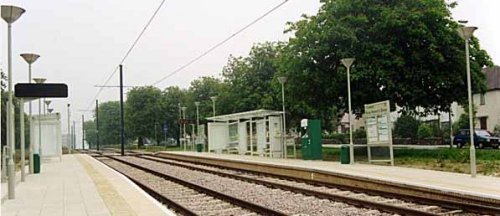
Photo
(c) 2000 John Bradshaw
|
| |
| Lamppost |
|
 Each
tram stop is lit at night by lights like this one at Gravel Hill. They
glow orange in the dark and each has its own sensor on top to turn it
on and off as it gets dark. Each
tram stop is lit at night by lights like this one at Gravel Hill. They
glow orange in the dark and each has its own sensor on top to turn it
on and off as it gets dark.
Return
to King Henry's Drive
|
| |
| CCTV
Camera |
|
 All
stops are covered by CCTV which is monitored in the Control Room at
Therapia Lane. This aids passenger security and provides a deterrent
against vandalism. The cameras are capable of turning in all directions
(unless restricted for residents privacy) and they have remarkable zoom
on them. Controllers are able to record evidence where necessary should
an incident occur. All stops have at least one camera. All
stops are covered by CCTV which is monitored in the Control Room at
Therapia Lane. This aids passenger security and provides a deterrent
against vandalism. The cameras are capable of turning in all directions
(unless restricted for residents privacy) and they have remarkable zoom
on them. Controllers are able to record evidence where necessary should
an incident occur. All stops have at least one camera.
If
the Passenger Help Point is activated, the camera automatically zooms
in on the Help Point, the picture is displayed on Control Room Monitor,
and recording is initiated.
See
the Control Room Page for more
information on the CCTV Controls.
Return
to King Henry's Drive
|
| |
| Passenger
Help Point |
 The
Passenger Help Points are provided for emergency use only. On pressing
the button, you are connected to the Control Room at Therapia Lane.
You can then talk to the Controller or they can talk to you. Once
the button is pressed, CCTV cameras zoom in on you and recording is
initiated. The
Passenger Help Points are provided for emergency use only. On pressing
the button, you are connected to the Control Room at Therapia Lane.
You can then talk to the Controller or they can talk to you. Once
the button is pressed, CCTV cameras zoom in on you and recording is
initiated.
Return
to King Henry's Drive
|
| |
| Passenger
Information Display |
|
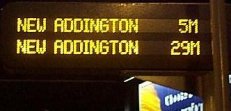 All
stops are equipped with an electronic Passenger Information Display
(PID) or Next Tram Indicator. These display the destination and expected
arrival times of the next two trams. They can also display any message
the controllers want to display. This could be information on delays
or even direct instructions to vandals to stop placing objects on the
track! All
stops are equipped with an electronic Passenger Information Display
(PID) or Next Tram Indicator. These display the destination and expected
arrival times of the next two trams. They can also display any message
the controllers want to display. This could be information on delays
or even direct instructions to vandals to stop placing objects on the
track!
For
further, more detailed information, see the Passenger
Information Display Page.
Return
to King Henry's Drive
|
| |
| Ticket
Machine |
|
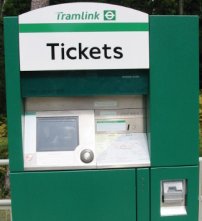 All
Stops have Schlumber ticket machines like this one. The machines feature
an electronic display and are operated by a simple toggle wheel. All
stops except Reeves Corner have at least 2. If one is out of order,
you should use the other. They are emptied daily and remotely monitored
from the Control Room. All
Stops have Schlumber ticket machines like this one. The machines feature
an electronic display and are operated by a simple toggle wheel. All
stops except Reeves Corner have at least 2. If one is out of order,
you should use the other. They are emptied daily and remotely monitored
from the Control Room.
For
more information, please see the Ticketing
Page.
Return
to King Henry's Drive
|
| |
| Noticeboard |
|
|
|
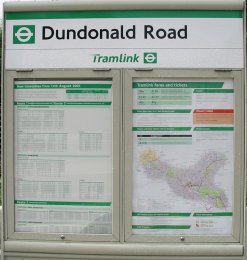 All
stops feature at least one Noticeboard. This has the stop name at the
top, the timetable in the left hand pane and a route map and other information
in the right hand pane. All
stops feature at least one Noticeboard. This has the stop name at the
top, the timetable in the left hand pane and a route map and other information
in the right hand pane.
Return
to King Henry's Drive
|
| |
| Shelter
and Seats |
|
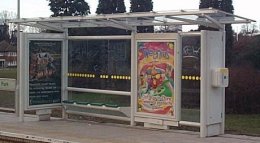 All
stops except Reeves Corner have seats and almost all stops have shelters
of some kind. These are of a modular design and the shelter size varies
depending on the number of people that are expected to be waiting at
that platform. For this reason, inbound platforms (towards Croydon)
often have larger shelters. Many shelters incorporate a BT Payphone.
All have lighting and most have illuminated advertising as part of the
structure. All
stops except Reeves Corner have seats and almost all stops have shelters
of some kind. These are of a modular design and the shelter size varies
depending on the number of people that are expected to be waiting at
that platform. For this reason, inbound platforms (towards Croydon)
often have larger shelters. Many shelters incorporate a BT Payphone.
All have lighting and most have illuminated advertising as part of the
structure.
Return
to King Henry's Drive
|
| |
| Litter
Bin |
|
 This
page would not be complete without the litter bin! Most stops have them.
There are two sizes, a free standing one (seen here) and a half size
one fixed to the back fence. They appear to be far too small for the
job and are often overflowing despite being emptied daily. They were
apparently designed mainly
for used tickets. New, larger bins have now been provided at some stops. This
page would not be complete without the litter bin! Most stops have them.
There are two sizes, a free standing one (seen here) and a half size
one fixed to the back fence. They appear to be far too small for the
job and are often overflowing despite being emptied daily. They were
apparently designed mainly
for used tickets. New, larger bins have now been provided at some stops.
Return
to King Henry's Drive
|
| |
|
|

|
| |
| Designed
by Trapdoor Internet
Services |




 Each
tram stop is lit at night by lights like this one at Gravel Hill. They
glow orange in the dark and each has its own sensor on top to turn it
on and off as it gets dark.
Each
tram stop is lit at night by lights like this one at Gravel Hill. They
glow orange in the dark and each has its own sensor on top to turn it
on and off as it gets dark. The
Passenger Help Points are provided for emergency use only. On pressing
the button, you are connected to the Control Room at Therapia Lane.
You can then talk to the Controller or they can talk to you. Once
the button is pressed, CCTV cameras zoom in on you and recording is
initiated.
The
Passenger Help Points are provided for emergency use only. On pressing
the button, you are connected to the Control Room at Therapia Lane.
You can then talk to the Controller or they can talk to you. Once
the button is pressed, CCTV cameras zoom in on you and recording is
initiated. All
stops are equipped with an electronic Passenger Information Display
(PID) or Next Tram Indicator. These display the destination and expected
arrival times of the next two trams. They can also display any message
the controllers want to display. This could be information on delays
or even direct instructions to vandals to stop placing objects on the
track!
All
stops are equipped with an electronic Passenger Information Display
(PID) or Next Tram Indicator. These display the destination and expected
arrival times of the next two trams. They can also display any message
the controllers want to display. This could be information on delays
or even direct instructions to vandals to stop placing objects on the
track! All
Stops have Schlumber ticket machines like this one. The machines feature
an electronic display and are operated by a simple toggle wheel. All
stops except Reeves Corner have at least 2. If one is out of order,
you should use the other. They are emptied daily and remotely monitored
from the Control Room.
All
Stops have Schlumber ticket machines like this one. The machines feature
an electronic display and are operated by a simple toggle wheel. All
stops except Reeves Corner have at least 2. If one is out of order,
you should use the other. They are emptied daily and remotely monitored
from the Control Room. All
stops feature at least one Noticeboard. This has the stop name at the
top, the timetable in the left hand pane and a route map and other information
in the right hand pane.
All
stops feature at least one Noticeboard. This has the stop name at the
top, the timetable in the left hand pane and a route map and other information
in the right hand pane. All
stops except Reeves Corner have seats and almost all stops have shelters
of some kind. These are of a modular design and the shelter size varies
depending on the number of people that are expected to be waiting at
that platform. For this reason, inbound platforms (towards Croydon)
often have larger shelters. Many shelters incorporate a BT Payphone.
All have lighting and most have illuminated advertising as part of the
structure.
All
stops except Reeves Corner have seats and almost all stops have shelters
of some kind. These are of a modular design and the shelter size varies
depending on the number of people that are expected to be waiting at
that platform. For this reason, inbound platforms (towards Croydon)
often have larger shelters. Many shelters incorporate a BT Payphone.
All have lighting and most have illuminated advertising as part of the
structure. This
page would not be complete without the litter bin! Most stops have them.
There are two sizes, a free standing one (seen here) and a half size
one fixed to the back fence. They appear to be far too small for the
job and are often overflowing despite being emptied daily. They were
apparently designed mainly
for used tickets. New, larger bins have now been provided at some stops.
This
page would not be complete without the litter bin! Most stops have them.
There are two sizes, a free standing one (seen here) and a half size
one fixed to the back fence. They appear to be far too small for the
job and are often overflowing despite being emptied daily. They were
apparently designed mainly
for used tickets. New, larger bins have now been provided at some stops.